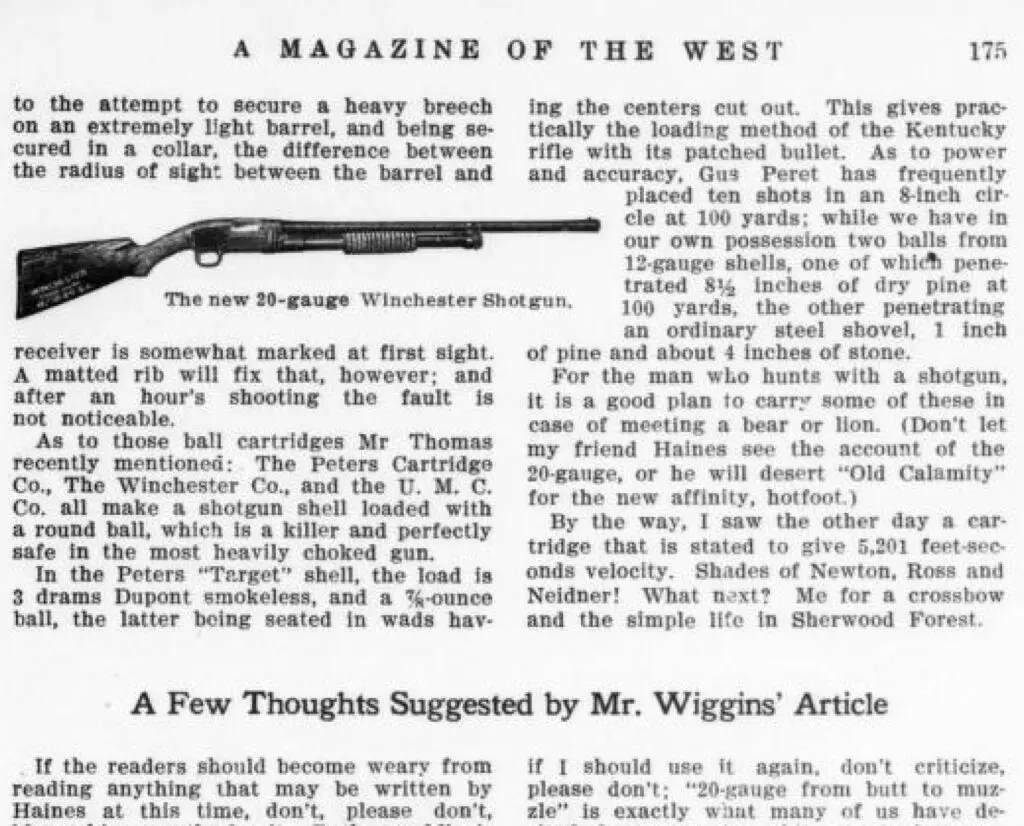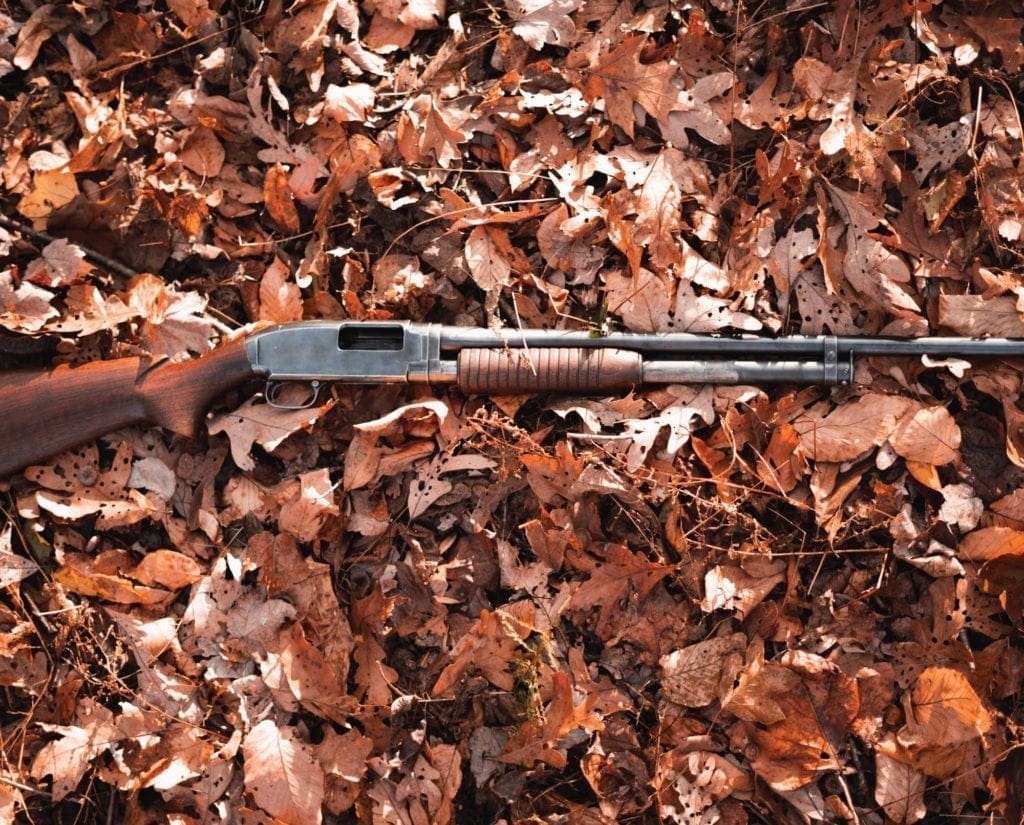Home » Firearms and Shooting » Shotguns » Winchester Model 12 Shotgun
Winchester Model 12 Shotgun

A.J. DeRosa, founder of Project Upland, is a New England…
The history, development, and current market value of the iconic American-made pump-action shotgun, the Winchester Model 1912.
Suppose one found themselves reading a newspaper in 1912. The headlines may have read, “New Mexico, Arizona Admitted as 47th and 48th States,” “Titanic Sank on its Maiden Voyage,” and “First Stop Light Invented in Detroit.” Between articles, you might have spotted a Winchester Repeating Firearms announcement for its new shotgun, the Winchester Model 1912. Its sales team coined it “the perfect repeater.”
Listen to more articles on Apple | Google | Spotify | Audible
The pump-action shotgun is a staple in the world of American wingshooting. The Winchester Model 12 is among the shooting world’s cast of popular models, and it was bested only by the Remington Model 870 in production numbers. Four years earlier, the unique Remington Model 10 was the first-ever bottom ejector introduced to the market, with over 275,000 produced until 1929.
The Winchester Model 1912, or simply the Model 12, was the American manufacturer’s first hammerless shotgun. Nearly two million of them were produced between 1912 and 1962. It saw action in four wars: World War I, World War II, Korea, and Vietnam.
Today, the shotgun is still popular on used gun shelves nationwide due to its versatile applications. The starting price of a used Model 12 in decent condition is around $450, and more pristine and high-end editions can fetch upwards of $1,500.

The Shotguns that Lead to the Winchester Model 1912
The history of the Winchester Model 1912 began with two hammered shotgun patents for John Browning’s Model 1893. Winchester used these patents to develop its first slide-action shotgun. While this shotgun was groundbreaking in its own right, its production was short-lived. Smokeless powder was invented in 1884, and the 1893’s action could not sustain it. In the four years of production, Winchester produced 34,050 of the Model 1893 until the Winchester Model 1897 replaced it.
The Model 1912, an improved hammerless version of the Model 1897, was developed by Winchester engineer Thomas Crossley Johnson. “Be it known that, Thomas C. Johnson, citizen of the United States, residing at Norman, in the county of Cleveland and State of Oklahoma, have invented certain new and useful Improvements in Pump-Operating Mechanism, of which the following is a specification,” reads the opening of Patent US-1027052-A, which was filed on May 21, 1912. Little did Johnson know that his four-page-long patent for the Winchester Model 1912 would become iconic.
While the Model 1912 was Johnson’s most successful patent, he also had a major failure when designing an auto-loading shotgun that didn’t infringe on John Browning’s designs. When trying to produce a semi-automatic model designed after the Browning Auto 5, the end product was the Winchester Model 1911, most commonly referred to as “The Widowmaker,” and not for good reasons.
The Production of the Winchester Model 1912
The most comprehensive history of the Winchester Repeating Arms Company was written by Herbert G. Houze in 1994. In his book, Winchester Repeating Arms Company: Its History and Development from 1865 to 1981, Houze points out an important shift in demand in the American market: the decreasing interest in centerfire rifles and a rise in the popularity of rimfire rifles and shotguns.
Beginning in 1905, the Winchester Repeating Arms Company began to receive requests from sportsmen worldwide for a light-weight hammerless repeating shotgun. By 1909, the demand had reached the level that T.G. Bennett requested that the work begin on such a design. Throughout that year and the two following. T.C. Johnson drew up the plans for an entirely new shotgun that met the requirements set by consumers. The resulting design, put into production as the Model 1912, surpassed all expectations and was to prove one of the most popular arms ever made by the company.
In 1913, the sales between the Model 1912 and Model 1897 were neck and neck. Thirty thousand and nine hundred Model 1897s were produced, besting the Model 12 by 3,785 shotguns. But in 1914, the Model 12 sold 47,347 shotguns, and the Model 1897 lagged behind at 17,519. By 1915, over 100,000 Model 12s had sold.
In 1933, Winchester began offering a second pump-action shotgun, the Model 42. Winchester produced 164,800 of this less-popular model until 1963. Over time, a cult following for the infamous .410 sub-gauge model has popped up.
The Winchester Model 1912’s production stayed much the same until a memo to senior management in 1943 cited notes on the Model 12, saying, “improve the smoothness of the action as it is criticized as being rough.” According to Houze, there was also interest in a “lightweight version” and an introduction of a 28-gauge.
The Model 1912 was officially discontinued as part of the Winchester lineup in 1963. Clean-up production resulted in the last Model 12 coming off the assembly line in 1966 with serial number 1970875, just shy of two million produced.

The Winchester Model 1912 and its War History
The Winchester Model 1912 saw its first war with World War I. The U.S. Military ordered 777 shotguns, including 600 riot editions, between 1917 and 1919 (Houze, 1994). The then-popular Model 1897 saw an order volume of 19,293, which accounts for the common misconception that 20,000 of the “perfect repeater” saw action in World War I.
World War II produced a total of 61,014 Model 1912 shotguns (Houze 1994). Of that, 19,207 were repaired by Winchester over the course of the war. These combined numbers have created the misconception that 80,000 Model 12 shotguns were produced for WWII. This iconic military shotgun saw action in the Korean War and was retired after the Vietnam War.
The Winchester Model 1912 Variants
Thomas Henshaw wrote in The History of Winchester Firearms 1866-1992 about the first variation of the Model 1912 offered. “It was first listed in the January 1913 catalog in 20 gauge, with a 25-inch round nickel steel barrel,” he said. “This was the first Winchester model to be chambered for 20 gauge. The 12 gauge and the 16 gauge were first listed in 1914, the 12 gauge Riot Gun in 1918, and the 28 gauge was authorized in 1934.”
The most complete reference to the Winchester Model 12 variants also appeared in Henshaw’s book. These include the Standard Field Gun, Tournament Grade, Special Trap Grade, Riot Gun, Trench Gun, Standard Trap Grade, M12 Trap Gun, Trap Gun, Trap Gun – Ladies and Junior (20-gauge), Skeet Gun, Heavy Duck Gun, Pigeon Grade, and Super Pigeon Grade. A Featherweight was also produced between 1957 and 1962. Variations in barrel length were available over the years, including 25, 26, 28, 30, and 32 inches.
The Model 12 comes with a fixed choke. Depending on the shotgun variation, the following chokes were produced: full, improved modified, modified, improved cylinder, No. 1 skeet, No. 2 skeet, and cylinder. All of them were chambered at 2 ¾ inches, except the Heavy Duck Gun, which came in a 3-inch version, and the 28 gauge, which was 2 ⅞ inches.
The following Field Gun weights are as follows:
- 12 gauge at 7 lbs. 5 oz.
- 16 gauge at 6 lbs. 9 oz.
- 20 gauge at 6 lbs. 5 oz
- 28 gauge at 7 lbs. 3 oz.

The Model 1912 Reintroduction and Current Market Value
The Model 1912 had one final act. Resurrected in 1972, it enjoyed production of a 12-gauge-only version until 1979, with a total of 26,299 produced. It ranks comfortably as history’s second-largest production run of a single pump-action shotgun.
Depending on the version of the Winchester Model 1912 one is searching for, prices can vary greatly. A shotgun in decent condition, such as a Field Gun, can start at as little as $400, while Trap versions can begin as high as $1,300. The 28-gauge version is the most valued by collectors, with fewer than 4,000 produced between 1932 and 1960. Current market prices can vary from $4,000 to $15,000, depending on the condition and variation.
The primary issue surrounding the Winchester Model 1912 is with the action cycling, which is understandable for a shotgun of this age. While a gunsmith can resolve some of these problems, there are certainly those beyond repair. Nevertheless, it can be a fun pump-action shotgun to add to the collection and take on your next wingshooting adventure.
A.J. DeRosa, founder of Project Upland, is a New England native with over 35 years of hunting experience across three continents. His passion for upland birds and side-by-side shotguns has taken him around the world, uncovering the stories of people and places connected to the uplands. First published in 2004, he wrote The Urban Deer Complex in 2014 and soon discovered a love for filmmaking, which led to the award-winning Project Upland film series. A.J.'s dedication to wildlife drives his advocacy for conservation policy and habitat funding at both federal and state levels. He serves as Vice Chair of the New Hampshire Fish & Game Commission, giving back to his community. You can often find A.J. and his Wirehaired Pointing Griffon, Grim, hunting in the mountains of New England—or wherever the birds lead them.




Good read. I have Pap’s( my grandfather) 1948 A-5 16 ga., 30″ full – Louisiana ‘duck gun’. I’ve shot a number of ducks with it and I took it on a Texas panhandle pheasant hunt a few years ago, taking a 3-rooster limit with it the first day. As in your gobbler story, my Pap never had a chance at wild pheasants. The 16 though performed quit well. I’ll pass it on to my son in a few years.
I have one of the reproduction guns in 20ga., 26”, IC choke. These pieces while reproductions are probably better made (fit and finish) than the originals. All the fine machine work that would be their death is why I love them so much!
Great story… I have my Great Grand Father Quail gun Model 12 20ga 24″ barrel choked Cylinder bore. Serial # 8003 produced in 1913. It has shot Quail in Texas,Georgia ,North Carolina and Grouse and Woodcock in the UP of Mich. Love the stories,history and proud to own it.
I have a pigeon trap, a Winchester later [browning] 20 gauge but the best & strongest is my Model 25 Winchester with its solid barrel no take down. For 50 + years my bad weather gun ducks geese rabbits quail dove & mountain lion[killing cattle]. It is the strongest smoothest pump made my MODEL @% WINCHESTER!!!. Jim Mayer
THE MODEL 25 is strongest model 12 Winchester PUMP ever
Great story! Well written.
You left out the model 120 before the 1200. Bought one for my son ( youth model,20 ga) @12 yrs old. He’s a 6′ ,48 yr old Spervisory Special Agent,FBI, and shoots it to this day. With the slide positioned more to the rear and a 23″ bbl, plus ltwt receiver it’s a perfect youth gun. For $25 we got a full size butt for when he grew.
Great story! Thank you! A question for ya – I’ve heard to only use lead shot in these OLD shotguns with fixed chokes. But this limits a lot I want to do with my 1955 Heavy Duck Model 12 I just picked up. Any thoughts?
From my Grandfather I have his 16ga. model 1912 Ser. # 4736
Thanks for posting this. Grandad died in 1974 when I was only four years old. Just last week I was honored to be handed down his Winchester Model 12. I was his first grandchild and really the only one he got to know at all due to his early passing. That is why my uncles decided to hand it down to me. What is really neat is that this gun was used in Marion County, Kansas near Peabody and Burns. So I could really relate to your Turkey story. I am hoping to do the same thing this coming Spring. Thanks again for the story!
I have my grandfathers and my dads model 12’s in 12 gauge. Both in awesome condition. Hope to pass them on to my son.
Stopped by your booth at Pheasant fest.
I own newer guns, I own fancier guns, but my favorite gun is my 16 gauge Model 12. It’s a classic.
Nice article, but which did you forget — Alaska or Hawaii?
Alaska and Hawaii were not admitted as states until 1959. (I did have to look that up.)
Oh my goodness how I love Winchester Model 12 shotguns!
You have captured much of the legend here, but your patent information is erroneous. You are currently displaying an image and text excerpts from Patent 1,027,052 awarded to T. J. Johnson of Kansas, whereas the designer of the Model 1912 was Thomas Crossly Johnson of New Haven, CT. If you have ever held a Model 12, you would see there is zero resemblance to the patent you show. Johnson’s design of the Model 12 included work from John Moses Browning on the 1893 and 1897 shotguns. You will find T.C. Johnson on Patent 855,181 for the wear adjustment mechanism on takedown guns.
Interested readers may also find enjoy The Winchester Model 12 by George Madis and Greatest Hammerless Repeating Shotgun Ever Built: The Model 12 – 1912-1964 by Dave Riffle.